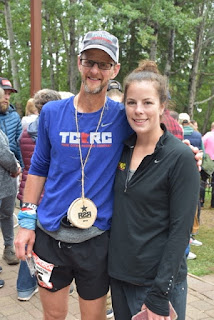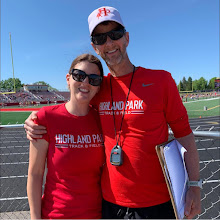More important to me than the RACE
RECAP and getting to the finish
line is how I got to the start line.
In that race recap I wrote about the seeds that were planted as far back as 10
years ago. But what finally lead them to take root? What was my “WHY” for doing
the race? What were the last 9 months of training like? What was my mindset
along the way? How did it all come together? These are the questions that I attempt
to answer here.
Journal entry 9/17/18 – note this is less than 2 weeks after
last year’s race:
The Compete and Strong books talk a lot about goal
setting, challenging yourself, not being afraid, etc. As I read from one of
these books last week, it hit me, I want to run the Superior 100 next fall.
I’ve always said that I don’t like being awake that long, let alone moving that
whole time and that I don’t think my body would enjoy it. But deep down I’ve
always wanted to see what it would be like – to see how far I could go and if I
could battle the mental side of the sport. Of course, there was always the fear
of failure, but I’ve been telling the cross-country kids that failure doesn’t
exist – we try something, we learn something, and then apply those learnings
going forward. Besides, if I “fail” I’ll be surrounded by like-minded people
and, most likely, a crew of great friends who would support me.
While I like to coach runners, I admit when I’m out of my
league – and training for 100M was definitely out of my league. Luckily, I
bumped into Sherri Schummer at a happy hour in October and I was able to pick
her brain. I first met Sherri in 2015 as I trained for my first 50M and she
trained for her first 100M. That year she finished Superior with less than an
hour to spare. Then last year, she ran 6 hours faster and was the 10th
woman. Obviously, she was doing something right. That “something” was being
directed by Coach Alicia Vargo.
On October 29th, I reached out to Alicia;
I’m friends with Sherri Schummer and have been extremely impressed with her improvement over the last few years. I’d like to run the Superior 100 next year too and am looking for a coach. I’m wondering 1) if you have any openings and 2) how long you typically like to work with a runner leading up to a race? When it comes to #2, I imagine “the longer the better” but I was wondering if I started in January, would 8 months be long enough?
She replied the same day;
Thank you so much for getting in contact with me. Sherri is such a tough gal and it has been a pleasure to work with her! I would love to see how I can best help you moving forward with your training and racing. Superior is such a unique and tedious (and beautiful!) 100 miler. It definitely necessitates a long, proper buildup. I think that 8 months would be prefect. I would probably structure your training, depending on where you are starting from, into two segments. A based building phase for 3.5 months, shorter break for 2 weeks and then 4 months of Superior specific training. January would work really well! I do have openings and it would be a pleasure to work with you! Please let me know if you have any additional questions or if you would like information on what we would need to do to get started.
Game on!
While Alicia handled the physical side of training, I knew
it was also important to work on my mindset. As I tell the marathoners I coach,
if we leave our thoughts to chance
for 3 to 6 hours, it’s very likely that they’ll turn negative. I can only
imagine the negative spiral that could take place during a 30+ hour race. To
help get my head on straight I turned to sports psychologist, Dr. Michael
Gervais – well I didn’t turn to him personally, but through his terrific
podcast, FINDING MASTERY, where he
interviews “tip of the arrow” performers.
Journal entry 6/11/19
Being scared shitless is giving way to confidence and
excitement… Feeling more confident because I’m able to get on the trails again,
because of the two 50Ks I raced, because of some power hiking workouts, along
with back-to-back longer runs.
One thing I’m working on is finding my ‘why’. I don’t want
the Superior 100M to be about racing / competing / numbers. Instead, I want to
focus on the process and let the outcome take care of itself.
Dr. Michael Gervais talks about the importance of clarity
of purpose and finding your “why”;
“The more extreme the environment, the greater the benefit of clarity of purpose holds. When pain is greater than purpose, we give into the pain. When purpose is clear, we can override the discomfort to move to the expression of purpose.”
Right now, my purpose for running the 100M is a tribute to
40 years of running, sort of my Love
Letter to Running, if I had to put a name on it. During hill repeats I’ve
been thinking about everyone I’ve met through running, typically going through
the different phases of my running life; my youth, high school, college, roads,
trails, MDRA, youth running, and so on. I also think about all the races I’ve
run, other events, and all running has given me.
Journal entry 7/30/19
I like the idea of spending time on the trail thinking of
everyone that I’ve met through running over the years. On the next few pages I’ve
tried to make a list of everyone that I can remember. I’m sure I missed a
bunch, but that’s not the point.
As someone who was concerned with sleep and being tired, I
heard a few things along the way that gave me confidence.
On the drive to South Dakota for the Black Hills 50M, I
heard a podcast where an ultra-athlete said that a 24-hour race isn’t really
long enough to get sleep deprived.
Also, Steve Tapajna (who ran his first 100M last year at
Superior) told me this summer that you don’t get sleepy when the sun goes down.
That was really good for me to hear.
Not sleep-related but I also heard that if you stay hydrated
and consume enough calories, you can do amazing things.
Dr. Gervais likes to say, “By doing the inner work, you earn
the right to tell yourself ‘I can do difficult things.’” For me, inner work
included defining my “why” as stated above, but also adding in a meditation
practice. I use the Headspace app. Also, a gamechanger for me has been doing yoga
twice per week. I used to have hip and back issues that seem to flare up 2-3
times per. Once the pain forced me to skip the Birkie ski race and just 2 years
ago I DNF’d at TCM. Soon after TCM I added yoga to my practice and I haven’t
had a flare up since.
As for the training itself, I don’t want to give away all of
Alicia’s secrets, but let’s just say I was shocked when I look back at my
weekly mileage. And, I mean, shocked because it was so low. From January 1st through August 31st, I
average less than 42 MPW. Other than when I ran the BH50 and ran 66 miles, my
largest week was 60 miles. And my largest month was 232 miles. I’ve had
marathon build ups with way more mileage.
That’s not to say the training was easy. The numbers don’t show
the back-to-back medium-long runs, or power hiking 15-20 hill repeats at Hyland
when it was 90 degrees out, or the last three long runs of 24, 27 and 30 miles –
the last one being a solo run on the SHT. There were definitely hard days, but
there was also a lot of recovery. It was just surprising to me, because I think
most people would associate 100M training with HUGE numbers in the log book.
As I mentioned above, I didn’t want this race to be about
time or place. The only reason I put any time down on paper was so that my crew
would have a better sense of when I’d arrive at aid stations. To help with this
I used the information on Course Record times into each aid station and
multiplied that by 50% to 67% in order to get a range. That seemed to work
pretty well as I compared this range of time to actual results for friends I
know from previous years. The problem with these previous results is that they were
all over the board. The same friend would run 26 hours one year, but 33 hours
the next.
After being set on my times for each aid station, Mallory
Richard’s STATISTICAL
ANALYSIS was posted. I reviewed my numbers with her method and tweaked a
few things to determine the final numbers that I gave to my crew.
Another thing that really helped was reading Kevin Langton’s
COURSE
DESCRIPTION . Going into the race I’d only been
on about half of the course, so this provided some great insight. Although I
will admit that most of that goes out the window when on the course.
All of this combined to bring me to the starting line
feeling incredibly calm. I wasn’t really sure why, however, the week after the
race Dr. Gervais explained why.
“There’s a relationship between skills and challenge. If the challenge is hard enough and you believe you have the skills to match that challenge, that’s the sweet spot. If you don’t believe you have the skills to match that challenge, that’s where we get anxiety. You might actually have the skills, but if you don’t believe, if you don’t trust yourself, that’s where we get sideways.” – Michael Gervais
I definitely believed that this challenge was hard enough,
but I also believed I had the skills to match the challenge.
 |
| Photo: Brian Beckman |










































